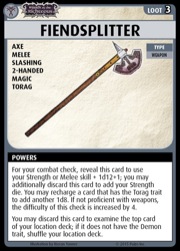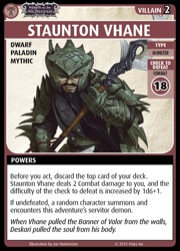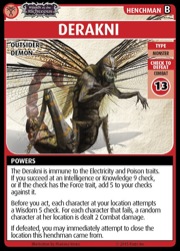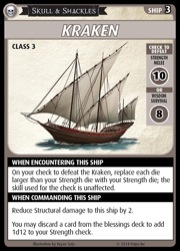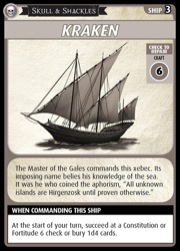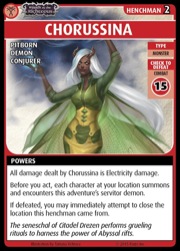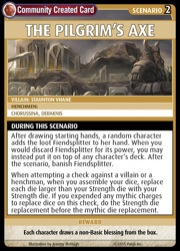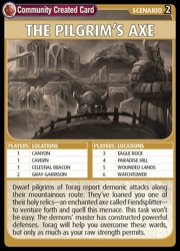Greetings, Pathfinders! This is the first in a recurring series of blog posts written by you. We're kicking things off with homebrew scenario creator extraordinaire Ron Lundeen. After reading this, I learned that Ron and I design scenarios in a similar way, so I can vouch for this excellent advice.
Hey, all! I'm Ron Lundeen, freelance author and avid Pathfinder Adventure Card Game fan. I'm here to give you a rundown on homebrew scenario design. I've released over 80 scenarios, including the very first fan-made scenario for the game and two full homebrew Adventure Paths: Shield of Rannick, which allows you to reuse all your Rise of the Runelords cards in a whole new way, and Bloodlust Corsairs, which does the same for Skull & Shackles. You can pick up these Adventure Paths and more for free at welbybumpus.com. Now that the "establishing my bona fides" and "hawking my work" bullet points are out of the way, let's talk scenario design. I'll break this down in four steps. Along the way, let's design a new scenario!
1. Fit the Story to the Cards, Not the Cards to the Story
First, find a few cards you'd like to use together in interesting ways. This is the most exciting part of scenario design for me, and I usually do it with the cards right in front of me. You might have an awesome scenario idea about a haughty nobleman protected by an army of obstinate bureaucrats, but without cards to fit those ideas, you won't get very far (which is where the card creator at DriveThru Cards could become your friend, but we're concentrating on scenarios you can make with cards that you already own.) So start with the cards, then build a simple story.
Our Scenario: Let's use Wrath of the Righteous. The loot card Fiendsplitter from Adventure Deck 3 is a powerful weapon devoted to Torag, righteous god of the dwarves, and the villain Staunton Vhane from Adventure Deck 2 is an evil dwarf. Perhaps those two can go together: Vhane has stirred up some group to attack dwarves who follow Torag. An evil dwarf seems like just the kind of guy to lurk in a remote Canyon or Cavern, preying upon pilgrims at a Celestial Beacon. We'll plan on using those locations. Plus, this set has Blessings of Torag—perhaps we can use those somehow. We now have the nucleus of our scenario!
2. Consider Where the Cards Are (or Could Be)
Certain cards are going to be required for your scenario—villains, henchmen, and locations, most likely. Those are pretty freely available for you to mix and match across adventure decks, or even across entire adventures. You don't want henchmen that are wildly more powerful than the villain (or vice versa), because the adventure will feel uneven. Building a scenario around cards other than villains, henchmen, and locations is a lot of fun, but must be done carefully. If your scenario requires other cards, consider whether they might already be in someone's deck; if so, don't use them, or set your scenario earlier than the cards would "appear" in your game.
Our Scenario: For Vhane's henchmen, let's use Deraknis. Vhane hasn't been paired with those before. I'd really like to use Blessings of Torag somehow—maybe shuffling all four of them into the Celestial Beacon to represent the pilgrims there—but those are base box blessings and therefore could be in players' decks already. So it's best not to have any special rule with those. Fiendsplitter is granted as loot in the third adventure, so we should set our scenario prior to adventure 3. Let's call it adventure 2 (which is also in line with our villains and henchmen). We'll banish Fiendsplitter at the end of the scenario; let's say the pilgrims of Torag loan it to the characters to put down Vhane.
3. The Scenario Designer Giveth and the Scenario Designer Taketh Away
Most scenarios have a factor that makes things easier and another that makes them harder. If you notice that a scenario has one fewer location than normal, you can bet it's going to have a rule making the scenario pretty tough (like needing to close all locations to win.) If the scenario has only one or two locations regardless of the number of players, you'd better strap in. For both easier and harder scenario rules, steal like crazy from anywhere in the game: villain powers, support card effects, and even character powers all provide good ideas for scenario-wide rules. Plus, the tricky part of including a rule—wording it clearly—has already been done for you.
Most scenarios mix locations that are beneficial and locations that are harmful. Mix those up as the number of players increases—you don't want to have only beneficial locations for smaller groups with the harmful locations showing up only for larger groups. But more importantly, choose locations that fit the theme of the story you're telling. If doing that makes the whole scenario feel a bit too easy or too hard, skew the scenario rules to compensate.
If your scenario is a one-off game that you intend as a detour from a published Adventure Path, the reward should be light: a single card draw is sensible. If you're designing an entire adventure—or even an entire Adventure Path—provide rewards at the same frequency as those provided by the published adventures.
Our Scenario: Let's have a scenario rule to make Fiendsplitter a bit better; we want to let multiple characters get a lot of use out of it. Some characters—like Alain and Radillo—can put useful cards on top of their decks, so let's create a power like that for Fiendsplitter. To ramp up the difficulty, and to keep the Torag theme, let's use a rule I swiped from the Kraken ship card from Skull & Shackles: against the villain or henchmen, characters must replace each die they roll that's larger than their Strength die with their Strength die. For locations, we already have the beneficial Celestial Beacon and the harmful Canyon and Cavern; let's include a few more locations appropriate for a pilgrim's trail through an isolated mountainous region. This is a one-off scenario where we anticipate being rewarded by holy pilgrims, so a non-Basic blessing is a reasonable reward.
4. Shake It Until You Break It
Once you have your scenario sketched out, test it a few times with groups of different characters and different sizes. The more you deviate from the standard scenario model, the more you should test it. Pay particular attention to where you've changed how an existing rule works, so you can see whether that makes other rules function oddly or whether the change disproportionately affects some characters more than others. If you find something like that, change it or build an exception around it. Or you can just pretend that's what you intended all along!
Our Scenario: Playtesting reveals that our scenario doesn't work for large groups—there aren't enough Derakni cards in the set to populate all the locations. We need to add one more henchman. I first thought about a Grimslake, but that seemed too tough in testing, so let's use Chorussina instead. After testing with a bunch of different characters, I found that the rule about limiting some checks to your Strength die doesn't really bother Crowe, but that's okay: Torag loves Crowe. The rule also particularly handicaps low-Strength characters like Seoni and Enora, so we'll make sure that characters who spend mythic charges to swap in d20s don't have their d20s knocked down to their Strength die. Low-Strength characters can then plan to reserve mythic charges for this circumstance.
Now we've got our final scenario, The Pilgrim's Axe. Give it a try and let me know what you think in the Homebrew and House Rules section of the Pathfinder Adventure Card Game forums. Better yet, post a scenario of your own!
Cheers!
Ron Lundeen
Contributing Author
If you've got an idea for an Adventure Card Game homebrew blog you want to write, send me your pitches at pacg@paizo.com!
Tanis O'Connor
Adventure Card Game Designer





